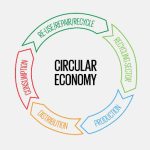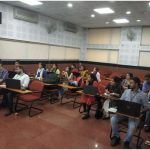Sure, my Professor Friend was not in a good mood yesterday. For strange reasons, only known to him, he was aggressive with me asking questions that I was not comfortable to answer.
Our coffee conversations began with a question.
“Dr Modak, have you heard about Environmental Impact Assessment 4.0?”
“No Professor”. I responded. I could see that Professor had some agenda in asking this question.
Over the years, EIA has matured both in research and practice deepening into areas such as Environmental Health Impact Assessment, Biodiversity Impact Assessment, Social Impact Assessment and Environmental Risk Assessment. Principles of Impact Assessment are used in areas such as Technology Assessment, Life Cycle Assessment and in developing management systems like ISO 14001 (remember the construct of aspect and impact?).
I knew about Industry 4.0 but had never come across the term EIA 4.0. I guess EIA 1.0 began with National Environmental Protection Act (NEPA) of USA in 1970 that introduced EIA at project level. Then was the era of Cumulative Impact Assessment that asked for Regional EIA i.e. EIA 2.0. Today regional EIAs embody considerations to Climate Change (EIA 2.9 perhaps). Later EIA got escalated to strategic level and got recognized as a tool for Policy EIA (EIA 3.0). So, what is EIA 4.0 then?
Professor saw that I was lost in my thoughts. He continued and asked me the next question.
“Dr Modak, today innovation, start-ups, impact funds etc are the buzz words with so much hulla gulla around. Another term that is on the sunrise is “disruptive technology”. Tell me who should be responsible for determining and evaluating the impact of disruptive technologies? Should this be the task of society, governments, academia or the business sector?”
That was a difficult question to answer.
Today, disruptive technologies include areas such as Autonomous vehicles — cars, drones, trucks, The Internet of Things, 3D printing, Renewable energy and energy storage, Advanced robotics with senses, dexterity, intelligence, Blockchain (and as of recently, hashgraph), Artificial intelligence and machine learning, Advanced materials, Gene editing, Spatial computing — augmented reality, virtual reality, Autonomous Transport and Next Gen Logistical Systems, Energy Systems (incl. Hydrogen Economy), Synthetic Biology etc.
Ideally, developers should be required to properly anticipate the potential risks and side-effects of disruptive technologies addressing economic, social and environmental dimensions. Unfortunately, right now, concerns about the potential adverse impacts of disruptive technologies seem to be left to the most vocal critics.
Take an example of 3-D printing. Many of you know that additive manufacturing (e.g. 3D printing) may provide custom-made and highly functional products, reduce the material intensity and weight of traditionally made products, and simplify logistical requirements through decentralized manufacturing, that takes place closer to customers. But at the same time this type of production may require more energy than conventional manufacturing; it may also potentially ramp-up resource consumption by providing affordable objects that are difficult to fix or even dismantle for waste-recovery purposes.
“Professor, do you think that we should legislate EIA of disruptive technologies or insist that the Impact Funds include in their ESGs, impact of the innovation itself on a broader canvas and not limit to narrow computations of economic and social returns?” I asked.
“Hold on your horses Dr Modak” Professor did not like my impatience. He started to explain.
Though the term ‘disruptive technologies’ is relatively new, the competitive effect of such innovations is much older. Take an example. Until the 1970s most of the world’s steel was made by large, integrated steel companies, that served all types of customers from users of high-end sheet steel to low-end ‘rebar’ steel for reinforcing cement. However, other manufacturers began to use minimill technology to enter the steel market, melting scrap metal in electric furnaces to produce steel more cheaply than the integrated companies. At first, minimills could only sell to the rebar market, and the integrated steel mills let rebar customers go in order to concentrate on the more profitable high-quality steel. But as their technology advanced, minimills were able to progress producing higher quality steel, encroaching further on the market served by integrated steel mills. Several integrated steel mills went bankrupt as their customer base was reduced to the high-end, low volume segments. So, while the industry got restructured, there was a significant economic and social impact. (Taken from LEK Consulting report)
The agricultural industry has already experienced significant change, but imagine autonomous tractors, smart robots, and connected land and water surveillance: humans won’t need to pick fruits and vegetables, spray crops, or survey their fields by plane or helicopter. Groceries will be delivered, and robots will have packed and shipped everything, Deliveries will be done by drones and there may not be the traditional mailman anymore. High-speed travel will make travelling from one city to another faster and easier: no more short-distance flights, airport hassle, or long road trips.
Not too far away in the future, we will face a significant number of disruptive technologies that will, in accordance with their nature, disrupt life and the economy and social systems. Jobs will be automated out and will change in nature, but equally new jobs will be created that don’t yet exist today. Technology and humans will become closer and humans will probably get away from the nature as a compromise.
Today, we know about technology assessment and impact assessment. What is missing is a form of midstream governance, which Hasselbalch labels as “innovation assessment”. That is essentially EIA 4.0 that integrates all the earlier versions.
Professor stopped as he lit his cigar.
“But Professor, how would you apply EIA 4.0. In India, as we are still at the level of EIA 1.0. Do you expect Department of Science and Technology to run EIA 4.0 while catalysing and supporting innovations?”. I retorted sounding a bit sceptical.
I remembered the methodology I developed called “Sustainability Assessment of Technologies (SAT)” for the UN Environment. May be this was EIA version 3.9!
“Dr Modak. The current regulatory approaches are ill-equipped to address this issue though some precautionary principles need to be put in place. Perhaps tools like System Dynamics could help build scenarios. More research is certainly needed and reporting of case studies to understand the impacts, Honestly, EIA 4.0 is innovators responsibility and that of the Impact Funds. Those who fund disruptive innovations should conduct impact assessment and a preparedness and management strategy just like EMP in EIA. And you need an “ecosystem” approach to contain the adverse impacts of disruption”
(but aren’t such innovations a special case as here early disclosures and stakeholder engagement processes may not be possible because of the secrecy and the IPRs)
“The World Bank has recently launched Disruptive Technologies for Development (DT4D) Challenge. The goal is to identify and pilot scalable disruptive technology solutions in World Bank Group (WBG) operations to maximize their development impact. The potential of Disruptive Technologies will be explored for integrated development with sub-themes such as integrated urban planning, transport, water, energy, waste, health, economy and land. To accelerate this process. The WBG announced the launch of the DT4D Fund in partnership with Credit Suisse to identify and pilot the use of disruptive technologies to foster sustainable, tech-enabled growth in developing countries.
“Oh, Professor, that sounds quite encouraging. But has the WBG subjected the DT4D fund to its own Environmental and Social Safeguards?” I couldn’t resist to ask
“I am not so sure Dr Modak”
Professor extinguished his cigar with his face a bit upset.







